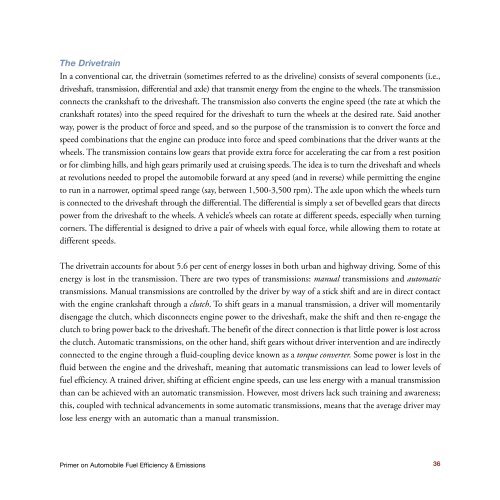Primer on Automobile Fuel Efficiency and Emissions - Pollution Probe
Primer on Automobile Fuel Efficiency and Emissions - Pollution Probe
Primer on Automobile Fuel Efficiency and Emissions - Pollution Probe
Create successful ePaper yourself
Turn your PDF publications into a flip-book with our unique Google optimized e-Paper software.
The Drivetrain<br />
In a c<strong>on</strong>venti<strong>on</strong>al car, the drivetrain (sometimes referred to as the driveline) c<strong>on</strong>sists of several comp<strong>on</strong>ents (i.e.,<br />
driveshaft, transmissi<strong>on</strong>, differential <strong>and</strong> axle) that transmit energy from the engine to the wheels. The transmissi<strong>on</strong><br />
c<strong>on</strong>nects the crankshaft to the driveshaft. The transmissi<strong>on</strong> also c<strong>on</strong>verts the engine speed (the rate at which the<br />
crankshaft rotates) into the speed required for the driveshaft to turn the wheels at the desired rate. Said another<br />
way, power is the product of force <strong>and</strong> speed, <strong>and</strong> so the purpose of the transmissi<strong>on</strong> is to c<strong>on</strong>vert the force <strong>and</strong><br />
speed combinati<strong>on</strong>s that the engine can produce into force <strong>and</strong> speed combinati<strong>on</strong>s that the driver wants at the<br />
wheels. The transmissi<strong>on</strong> c<strong>on</strong>tains low gears that provide extra force for accelerating the car from a rest positi<strong>on</strong><br />
or for climbing hills, <strong>and</strong> high gears primarily used at cruising speeds. The idea is to turn the driveshaft <strong>and</strong> wheels<br />
at revoluti<strong>on</strong>s needed to propel the automobile forward at any speed (<strong>and</strong> in reverse) while permitting the engine<br />
to run in a narrower, optimal speed range (say, between 1,500-3,500 rpm). The axle up<strong>on</strong> which the wheels turn<br />
is c<strong>on</strong>nected to the driveshaft through the differential. The differential is simply a set of bevelled gears that directs<br />
power from the driveshaft to the wheels. A vehicle’s wheels can rotate at different speeds, especially when turning<br />
corners. The differential is designed to drive a pair of wheels with equal force, while allowing them to rotate at<br />
different speeds.<br />
The drivetrain accounts for about 5.6 per cent of energy losses in both urban <strong>and</strong> highway driving. Some of this<br />
energy is lost in the transmissi<strong>on</strong>. There are two types of transmissi<strong>on</strong>s: manual transmissi<strong>on</strong>s <strong>and</strong> automatic<br />
transmissi<strong>on</strong>s. Manual transmissi<strong>on</strong>s are c<strong>on</strong>trolled by the driver by way of a stick shift <strong>and</strong> are in direct c<strong>on</strong>tact<br />
with the engine crankshaft through a clutch. To shift gears in a manual transmissi<strong>on</strong>, a driver will momentarily<br />
disengage the clutch, which disc<strong>on</strong>nects engine power to the driveshaft, make the shift <strong>and</strong> then re-engage the<br />
clutch to bring power back to the driveshaft. The benefit of the direct c<strong>on</strong>necti<strong>on</strong> is that little power is lost across<br />
the clutch. Automatic transmissi<strong>on</strong>s, <strong>on</strong> the other h<strong>and</strong>, shift gears without driver interventi<strong>on</strong> <strong>and</strong> are indirectly<br />
c<strong>on</strong>nected to the engine through a fluid-coupling device known as a torque c<strong>on</strong>verter. Some power is lost in the<br />
fluid between the engine <strong>and</strong> the driveshaft, meaning that automatic transmissi<strong>on</strong>s can lead to lower levels of<br />
fuel efficiency. A trained driver, shifting at efficient engine speeds, can use less energy with a manual transmissi<strong>on</strong><br />
than can be achieved with an automatic transmissi<strong>on</strong>. However, most drivers lack such training <strong>and</strong> awareness;<br />
this, coupled with technical advancements in some automatic transmissi<strong>on</strong>s, means that the average driver may<br />
lose less energy with an automatic than a manual transmissi<strong>on</strong>.<br />
<str<strong>on</strong>g>Primer</str<strong>on</strong>g> <strong>on</strong> <strong>Automobile</strong> <strong>Fuel</strong> <strong>Efficiency</strong> & Emissi<strong>on</strong>s<br />
36
















